Civil Aviation, India/ 1
| Line 1: | Line 1: | ||
| − | [[File: Top | + | [[File: hourly peak runway aircraft movement at India’s Top 9 airports.jpg| As of Sept 2016 India’s airlines have less than 400 planes. However, they have ordered more (details above). Will Indian airports be able to handle them? This graphic gives the hourly peak runway aircraft movement at India’s Top 9 airports. <br/> [http://epaperbeta.timesofindia.com/Gallery.aspx?id=29_09_2016_013_013_007&type=P&artUrl=Hundreds-of-new-planes-flying-in-But-wheres-29092016013013&eid=31808 ''The Times of India'']|frame|500px]] |
[[File: Status of airlines in India, July 2015, market share, occupancy, punctuality.jpg|Status of airlines in India, July 2015: market share, occupancy, punctuality; Graphic courtesy: [http://epaperbeta.timesofindia.com/Gallery.aspx?id=19_08_2015_028_034_002&type=P&artUrl=TAKING-TO-SKIES-19082015028034&eid=31808 ''The Times of India''], August 19, 2015|frame|500px]] | [[File: Status of airlines in India, July 2015, market share, occupancy, punctuality.jpg|Status of airlines in India, July 2015: market share, occupancy, punctuality; Graphic courtesy: [http://epaperbeta.timesofindia.com/Gallery.aspx?id=19_08_2015_028_034_002&type=P&artUrl=TAKING-TO-SKIES-19082015028034&eid=31808 ''The Times of India''], August 19, 2015|frame|500px]] | ||
| + | [[File: Top 20 city-pairs with highest international air traffic in 2013-14.jpg|Top 20 city-pairs with highest international air traffic in 2013-14; Graphic courtesy: [http://epaperbeta.timesofindia.com/Gallery.aspx?id=31_08_2015_006_015_004&type=P&artUrl=STATOISTICS-BRIDGING-THE-GULF-31082015006015&eid=31808 ''The Times of India'']|frame|500px]] | ||
{| Class="wikitable" | {| Class="wikitable" | ||
|- | |- | ||
Revision as of 20:06, 18 January 2017

The Times of India
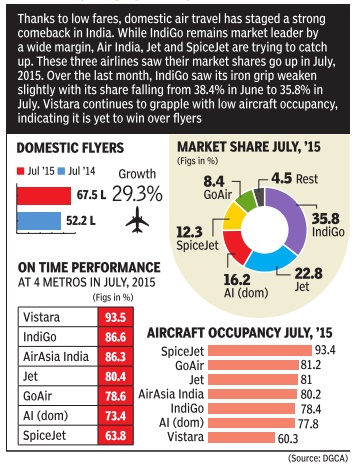
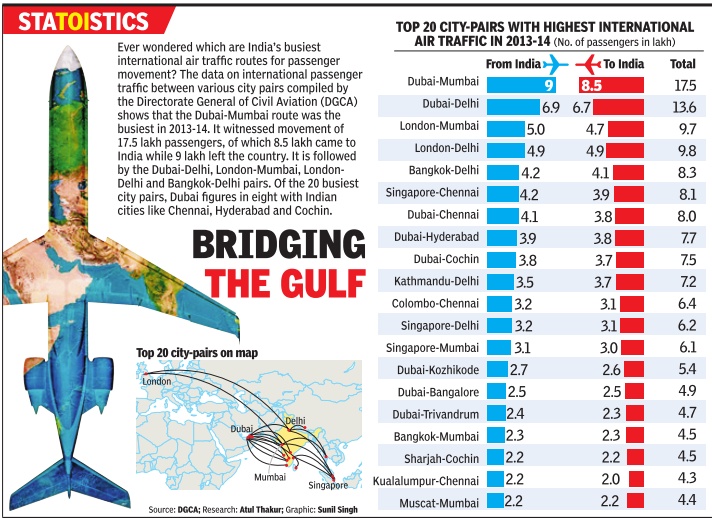
This is a collection of articles archived for the excellence of their content. |
Accidents
See graphic.
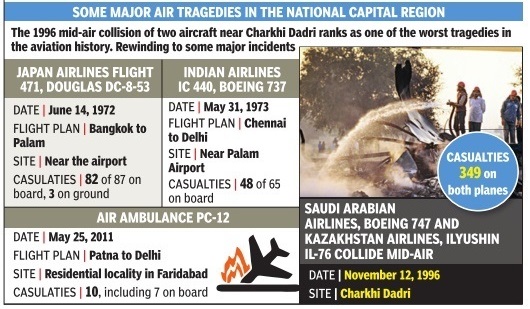
Acquisition, purchase of aircraft
June 2016: Importing older planes
The Hindu, June 27, 2016
Airlines can now import older planes
Domestic airlines can now import aircraft that are up to 18 years old into the country with the government amending more than two-decade rules in this regard.
The move is expected to provide a fillip for the government’s ambitious efforts to boost regional air connectivity as it gives more leeway for operators in expanding their fleet.
Till now, aircraft that are more than 15 years old were not allowed to be imported.
Doing business
As part of larger efforts to improve the ease of doing business in the domestic aviation sector, which has huge growth potential, the Directorate General of Civil Aviation (DGCA) has made changes to rules that had come into effect way back in July 1993.
With the revised norms, pressurised aircraft that are not over 18 years old or those which have not completed 50 per cent of design economic pressurisation cycle can be imported.
A pressurised aircraft is one which is equipped to handle cabin pressure at an altitude of above 10,000 feet.
Such planes should not have completed “15 years of age or 75 per cent of design economic life or 45,000 pressurisation cycle.”
The regulations would be applicable for entities having scheduled, non-scheduled and general aviation operations.
“Considering that modern commercial air transport jet aircraft are significant economic assets that can have an effective economic useful life of decades, the restriction imposed on import of aged aircraft is cautiously revised,” the latest CAR signed by DGCA chief M Sathiyavathy said.
Civil Aviation Requirements: CAR
In this regard, changes have been made in the relevant norms or Civil Aviation Requirements (CAR) effective from June 17.
“Aircraft intended to be imported for air cargo operations shall not have completed 25 years in age or 75 per cent of its design economic cycles or 45,000 landing cycles,” it noted.
The regulator also said that studies were conducted by international aviation community on the correlation between fatal accidents and age of the aircraft.
“Such studies have not clearly established that there is a correlation between accident rate and aircraft age up till 18 years,” it added.
Unpressurised aircraft
With respect to unpressurised aircraft, the decision would be taken on a case to case basis after examining the record of the plane that is to be procured from overseas.
“However, DGCA would normally not allow such aircraft which are more than 20 years old,” it said.
The watchdog noted that aircraft intended to be imported and used for scheduled commercial operations should have their design economic calendar and operational life clearly established by the holder of type certificate, among other requirements. Aircraft manufacturers usually prescribe design standards.
Air routes, the busiest
2014
See graphics The Times of India



Feb 09 2015
Saurabh Sinha
Mumbai-Dubai busiest route in 2014
Delhi-Dubai Second With 13.6L Flyers
The Mumbai-Dubai sector was the busiest international city pair for travel to and from India last year.With as many as 17.5 lakh people flying between these two cities, closely followed by 13.6 lakh between Delhi and Dubai, the Emirate emerged as the destination most frequented by Indians . Dubai saw a whopping 84.5 lakh people flying to and from India last year, way ahead of the second spot of almost 44 lakh occupied by the rest of UAE -of which it too is a part. London, Bangkok, Singapore and Kathmandu were the other major destinations or transit points for Indian globetrotters last year.
India is an important market for all airlines as interna tional travel has been constantly growing in the past few years. Forget metros, even small towns are generating huge volumes of traffic.For instance, 4.5 lakh people flew between Sharjah and Kochi last year. Thiruvananthapuram and Dubai saw 4.7 lakh people flying between them last year. Pune, Varanasi and Amritsar also saw substantial numbers flying to overseas destinations.
While domestic air travel has seen its share of ups and downs in the past seven years, international air travel has been growing at almost 10%. The next round of growth is expected from small towns. The aviation ministry is allowing new airlines to take shape and is focussing on promoting regional connectivity . It is also planning to make it easier for new airlines to fly abroad.
With these moves, it hopes to counter the dominance of foreign, especially Gulf, carriers.
Dubai's dominance comes from the fact that its airline, Emirates, rules Indian skies and is the third largest carrier in India in terms of international market share.
All Indian carriers that fly abroad -Jet Airways, Air India, IndiGo and SpiceJet -also fly to Dubai. While they offer only point-to-point connectivity between India and Dubai, Emirates offers connectivity to rest of the world for Indian flyers from its hub, making it a virtual Pied Piper for Indian travellers. “Star Alliance accepted Air India into its fold mainly to counter the onslaught of Gulf carriers. Emirates is already known as the de facto national airline of India. Abu Dhabibased Etihad's tie-up with Jet Airways means that Jet will feed that hub from 23 cities in India. Together, Gulf carriers pose the biggest challenge not only for Indian carriers but also other airlines that fly into India,“ said an airline official.
With Jet going the Gulf way , Indian aviation has pinned its hopes on AI weaning away long-haul traffic from them with its new-found Star Alliance membership and the joint venture between Tatas and Singapore Airlines, Vistara.
“IndiGo, SpiceJet and GoAir, when it starts flying abroad, will go only to nearby international destinations.Vistara has the capability to quickly mount long haul flights if the rule for Indian carriers to fly abroad is relaxed,“ said an airline official.
Annual growth/ decline in traffic
2014/ No. of fliers rises 10%
Jan 20 2015
Give low fares and Indians will fly like never before. The constant flash sales by SpiceJet last year, which forced other carriers to follow suit, has led to a record 6.7 crore people flying within India in 2014. In December, 64.4 lakh flyers took off within the country, possibly the highest ever number of people flew in a month.
But SpiceJet, which started the fare war, saw itself running out of cash by November, which led to aircraft leasors repossessing many of its Boeing 737 aircraft. Since November, the airline saw its market share fall. In December 2014, its market share was 10.4%, down from 20.4% in July . The low cost carrier is now headed for a change of ownership with co-founder Ajay Singh back in the cockpit.
2014: No. of passengers
The Times of India, Sep 06 2015
As air travel becomes easier and cheaper, more and more travellers are choosing to fly. Flight departure data collected by the World Bank shows that the US recorded over 95 lakh flights leaving from its airports in 2014, followed by China with 33 lakh. In comparison, India clocked only 7.2 lakh
August 2015: domestic fliers
The Times of India, Sep 23 2015
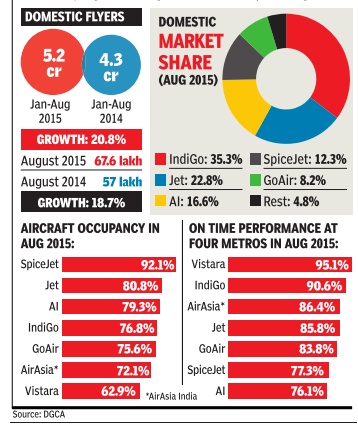
Low fares have made Indian skies a crowded place once again.Deep-discount carrier SpiceJet has been enjoying maximum aircraft occupancy for five months in a row, while full service Vistara is yet to catch flyers fancy. With low-cost carriers ruling the skies, the time has come for budget terminals in India -without sky-high user charges -to meet next phase of growth
2015: India, fastest growing air travel market
The Times of India, Oct 02 2015

India fastest growing air travel mkt globally: IATA
Thanks to low fares and increase in capacity with launch of new airlines, India is now witnessing the highest growth in domestic air traffic globally.
The International Air Transport Association (IATA) said India's domestic passenger traffic demand grew the fastest among seven major aviation markets of the world -Australia, Brazil, China, Japan, Russian Federation and the US.
“India's domestic demand surged 18.3% in August (2015) compared to a year ago, largely reflecting increases in service frequencies and economic strength,“ IATA said. India's growth was followed by China at 13.6% and the Russian Federation at 10.9%.
India's domestic traffic ro se 28% in July , 16.3% in June; 18.2% in May , 20.7% in April and 17.9% in March 2015. August's 18.3% growth, though lower than the growth registered in July, was the fastest globally for that month. India's domestic capacity in the month under review rose 8.4% compa red to August 2014.
“August figures show continuation of the trend of strong demand for air travel, despite some softening in global economic growth, particularly in emerging markets,“ said Tony Tyler, IATA's DG and CEO.
2015: 20% rise in domestic air travel
[[File: 2015, domestic flights in India, number of flyers, airlines’ market share, load factor and on-time performance.jpg|2015: Domestic flights in India: number of flyers, airlines’ market share, load factor and on-time performance; Graphic courtesy: The Times of India, January 19, 2016
20% jump in domestic air travel in 2015
Domestic air travel rose by 20.3% in 2015 over the previous year, registering one of the highest growth rates in the past decade. A record 8.1 crore domestic flyers took to the skies last year, with December logging the highest-ever monthly traffic of over 77 lakh. Low oil prices, which led to airlines offering cheap air fares, lured travellers back. To top low fares, airlines added capacity and frequencies.
Compensation
Compensation for delays, accidents
Mar 19 2015
Flyers set for higher payoffs from airlines
Accidents, delays to cost carriers more
The Narendra Modi government has enhanced the compensation that airlines must pay passengers in case of lost baggage or suffering an injury while travelling with them. If a person dies or suffers bodily injury in an air crash or some other aviation-related accident, the compensation payabale to the family is now Rs 90 lakh, up from Rs 75 lakh earlier.
In case of inordinate flight delays, the compensation could now be as high as Rs 3.5 lakh, up from Rs 3 lakh earlier. The maximum compensation for lost baggage has now been upped to about Rs 84,000 from Rs 74,000 earlier.
The enhanced compensa tion comes with the Cabinet on Tuesday amending the Air Carriage Act that deals with issues like damages to be paid for flight delays, loss of baggage and accidental death. Indian carriers will now pay as their international counterparts, in line with the 1999 Montreal Convention that governs airline liability and compensation.
These compensations are based on something called special drawing rights (SDR), with each SDR worth $1.2.
In India, SDRs are converted into Indian rupees depending on the exchange rate at the time of payment. Damage in case of death or bodily injury for each person has been upped from a lakh SDR to 1,13,100 SDR. The liability in case of destruction, loss or delay of cargo has been raised from 17 SDR (Rs 1,265) to 19 SDR (Rs 1,400).
The change came as International Civil Aviation Organisation (ICAO) calculated that inflation had risen by over 10% -the trigger for a recalculation. In India, the change came with the Cabinet clearing an amendment to the Carriage by Air Act by inserting a new provision enabling the government to revise the limits of liability as and when the revised limits are notified by the ICAO. India had signed the Montreal Convention in May 2009. Also, the Convention stipulates that the compensation figures must be revised every five years.
Defence airspaces
2015: Shortening routes over defence airspace
The Times of India, Jul 27 2015

Ayyappan V
Flight time shortens as defence airspace opens
Airlines save on fuel and time by avoiding detours
A Kolkata-bound flight taking off from Hyderabad first flies eastward to reach the coast and then takes a northerly route with more deviations to reach its destination. The route has been designed to avoid military installations at Begumpet near Hyderabad and at Barrackpore near Kolkata. But with the restricted military airspace being opened up for civilian flights last month, pilots can now take a direct northerly path.
Airports Authority of India (AAI) has started implementing flexible use of airspace which allows civilian aircraft to fly over military installations. This allows airliners to save fuel and time besides avoiding unnecessary detours. In June, the Kolkata-Hyderabad route was opened and this saves almost 15 minutes of flying time. As this been successful, AAI is planning to allow flights to use military airspace on the Delhi-Goa route on weekends and on the Nagpur-Pune route on Sundays very soon. Military airspace, used for training and sorties, is marked as restricted areas on aviation charts . Civil airliners have to avoid such paths even when air force or navy planes are not flying. After much deliberation , defence ministry has decided to relax rules.
The proposal was made many years ago and was approved in 2013. Implementation has picked up momentum now. AAI has begun training air traffic controllers and staff, and has drawn up a manual to conduct route-specific trials between cities where detours are lengthier. The first was conducted between Kolkata and Jaipur.
An airline official said, “There was a training programme in Delhi in June. Another meeting was held in Hyderabad last week. The concept will improve safety as there will be less number of restrictions for pilots and air traffic controller.“
Chennai, though, has not been considered as of now since it is located at the farthest corner and does not fall between flight routes connecting major cities. The aim now is to eliminate detours of cross-country flights.
But Chennai would benefit if detours a flight takes before nearing the city airport come into focus. Flight paths over the city will be decongested if routes to the airport are designed to bypass the airspace used by Tambaram air force station and Arakkonam naval station. Flexible use of airspace will be beneficial for Benguluru and Chennai which are surrounded by military installations.
An AAI official said civil-military aviation cooperation is also being carried out as per the direction of International Civil Aviation Organisation which says that “shared use of airspace by civil and military aviation shall be arranged to ensure safety, regularity and efficiency of international civil aviation as well as the requirements of military air traffic.”
Delayed flights
Budget airlines to offer food: SC
Dhananjay Mahapatra TNN
The Times of India, July 9, 2011
New Delhi: Low-cost airlines cannot hide behind the “no free meal” clause printed on tickets to refuse food to passengers if the flight gets delayed by three hours. In an important judgment, the Supreme Court ruled that the exclusion clause not to provide meals would apply only to passengers who had not boarded the flight and were free to purchase food at the airport.
“It will not apply to passengers who are on board and a delay in the flight taking off denies them access to food and water,” said a bench of Justices R V Raveendran and A K Patnaik, while absolving IndiGo of any wrongdoing in a case of alleged ill-treatment of passengers on a fog-delayed flight in 2007.
“In the extraordinary situation where passengers are physically under the complete care and control of the airline, as it happens when they have boarded the aircraft and have no freedom to alight, the duty of the airline to protect and care for them-...would prevail over any term of contract excluding any facilitation, except when the carrier itself cannot access food due to emergency situation,” the bench said. “No public utility service can say it is not bound to care for the health, welfare and safety of the passengers because it is a low cost carrier,” said Justice Raveendran, who authored the judgment.
Three-hour delay will entitle flyers to food, says SC
Low-cost airlines must provide meals to passengers, who have already boarded, in case there is a delay in the flight taking off, said a Supreme Court bench of Justices R V Raveendran and A K Patnaik while absolving IndiGo of any wrongdoing in a case of alleged ill-treatment of passengers on a fog-delayed flight in 2007.
Government Policies
2016: New Aviation Policy
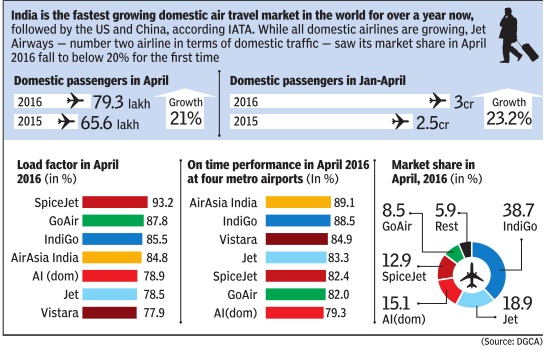
The Times of India, Jun 16 2016
Aviation policy puts small towns on the map for flyers
One may soon be able to fly to Bikaner or Bathinda, with the government aiming to put small towns on the aviation map and capping fares at Rs 2,500 an hour for locations that have so far been untouched by air connectivity . While there is a ceiling on fares, those flying from metros or large cities will have to pay a “small levy“ to fund building of no-frills airports.The Centre and states will chip in with funds and other concessions.
The plan, which has been in the works for the past few months, is part of the new civil aviation policy that was approved by the Cabinet. Announcing the policy , civil aviation minister Ashok Gajapathi Raju ruled out capping domestic air fares on existing routes, leaving it to market forces.
In addition, a new policy for helicopters, including setting up of four heliports, and allowing choppers to fly under 5,000 feet in unrestricted airspace without ATC clearance has been proposed in the new policy .
India is the fastest grow ing aviation market, clocking 22% rise in domestic traffic; the government hopes to increase the number of flyers to 30 crore by 2022, from eight crore currently. The new aviation policy announced on Wednesday aims to step up the growth rate and boost tourism while making air travel affordable for the aam aadmi.
“Regional connectivity, where the capping of fares has been announced, will benefit flyers greatly. For instance, there are no flights between Bangalore and Mysore simply because there is no passenger load factor. It's a 30 minute flight. If the fare costs Rs 1,200 many would prefer to fly,“ said Sudhakara Reddy, president of consumer group Air Passengers Association of India.
Aviation secretary R N Choubey said distance from airports was one of the key factors deterring people from flying to smaller towns. “NDA govt clears India's first ever integrated National Civil Aviation Policy. This will be a gamechanger for the sector... Regional Connectivity Sche me (RCS) --to revive unserved airports and routes in Tier II III cities,“ Raju tweeted. His deputy, Mahesh Sharma said the government would look to build 5080 no-frills airports across the country, many of them using airstrips that had been abandoned after World War II.
Each such airport is expected to cost between Rs 50 and Rs 100 crore and would come up in states which offer lower VAT on aviation fuel, provide police and fire services free of cost and supply power and water atconcessional rates.
On its part, the Centre will offer lower service tax and bear 80% of the burden to make flying to these destinations financially viable.But the key will be lower state levies on fuel as it accounts for nearly half the fare, Choubey told reporters at press conference.
States levy as much as 25% high value added tax on aviation turbine fuel, pushing up fares.
Laws and rules
The Air Corporation Act, 2016
The Times of IndiaJan 06 2015
The Air Corporation Act of 1953 nationalized the airlines industry in India.The liberalization of the sector started in 1986 when private players were allowed to run air taxis. In 1994, the Air Corporation Act was repealed and private companies were allowed to operate scheduled commercial flights.Airlines registered in India showed an impressive increase of over 600% in passenger volume between 1991 and 2013, when India was ranked 9th in the world in passenger volume. Among the 20 countries registering the highest passenger air traffic, the growth of civil aviation has been even higher over this period in the UAE, Turkey, Ireland and China
The Carriage by Air (Amendment) Bill, 2016
The Times of India, Mar 12 2016

Saurabh Sinha
Bill for higher air mishap damages gets LS approval
Parliament approved a bill providing for enhanced compensation to air travellers in case of death, injury , lost baggage or even inordinate delay in flights, with the Lok Sabha passing it with minor amendments. The Carriage by Air (Amendment) Bill was passed by the Lok Sabha in December 2015 and by Rajya Sabha, with minor amendments, on March 2, 2016. The bill, along with the amendments, came back to the lower House and was adopted by a voice vote. As per provisions of the bill, the compensation for death in an air accident will be calculated on the basis of Special Drawing Rights (SDR).The bill intends to raise the liability limit for damages in case of death or bodily injury for each person from 100,000 SDR to 113,100 SDR. The currency value of the SDR is based on market exchange rates of a basket of major currencies -US dollar, euro, Japanese yen and pound sterling. As per the latest exchange rate, the compensation limit rises to more than Rs 1 crore. One SDR is equivalent to around Rs 93 at present.
The bill also proposes to raise the liability for delay in carriage for each person from 4,150 SDR to 4,694 SDR, while the liability in case of destruction, loss, damage or delay of baggage will be raised from 1,000 SDR to 1,131SDR.
India's aviation security regulator is all set to get more teeth, with the government sanctioning a three-fold increase in the manpower of Bureau of Civil Aviation Security (BCAS) to take it from 190 to 600. “The impact of this move will be that BCAS will have presence at all airports. As of now, we have eight regional offices. This number will go up to 20. The regulatory agency will be reorganised and revamped,“ said an official. The recruitment for the additional posts has begun. But the government will have to make a start by appointing a person to head BCAS. B B Dash, joint commissioner, has been officiating as the commissioner of the agency. But his five-year term gets over in three months..
Photography
“Air side“ photography
Saurabh Sinha DGCA bars clicking pics near aircraft Sep 15 2016 : The Times of India (Delhi)
Flyers will no longer be allowed to take pictures or selfies while boarding or alighting from aircraft. The Directorate General of Civil Aviation has reinforced restrictions on “air side“ photography by passengers in a new rule issued primarily to prohibit pilots from taking selfies in cockpits of airborne planes as the regulator has found the latter to be a major distraction that could affect safety .
A DGCA air safety circular issued on August 29 has asked airlines to ensure that “passengers do not indulge into photography while embarkingdisembarking from aircraft.“ Also, passengers will no longer be able to request crew to let them in the cockpit to click a quick selfie while disembarking. In fact, photography inside cockpit has been banned for crew also in all phases of flight and not just while flying.
Security of flying aircraft
Bay of Bengal flights gets safer
The Times of India Jan 11 2016
Chennai
TIMES NEWS NETWORK
Flying over Chennai airspace has become safer for international flights as air traffic controllers can now track them better over the Bay of Bengal.
In a bid to enhance safety and monitoring of planes better, Airports Authority of India (AAI) has bifurcated the oceanic airspace, spread over 4 lakh square nautical miles till the Andaman and Nicobar Islands, into west and east regions.
The airspace is crucial for global air connectivity because 400 planes cruise along 14 international routes connecting Europe to Australia and the Far East everyday , over an expansive water body where tracking planes is difficult. This traffic is in addition to the domestic traffic from Chennai and Kolkata to Port Blair. Now, two dedicated teams of air traffic controllers will monitor planes flying in their respective regions so that they will not miss any flights in the airspace that is traffic-intense yet difficult to monitor because radar coverage is not efficient over such a vast area.The system will help overcome blind spots where air traffic controllers will not get signals showing movement o planes on their monitors.
Chennai has the largest airspace spread over the ocean where flights are cur rently monitored using voice communication with very high frequency (VHF) and high frequency telephony controller-pilot datalink, sat ellite phones and satellite based automatic dependent surveillance broadcast used as a backup for radar.
“The airspace has been made into two sectors based on traffic density and workload of controllers, traffic density and the number of points where air routes intersect. This will be implemented in three phases on trial and is expected to help airlines fly at their optimum level and save fuel and time,“ said a senior AAI official.
AAI board member for ANS A K Dutta inaugurated the facility on Saturday and said several such system were being implemented to help airlines cut down on fuel, operational cost and emission. AAI also introduced SMode operation to allow air traffic controllers to identify a plane as soon as they see a blip on their screens based on a code set by the crew.
Traffic at International Airports
2013-14
Jan 15, 2015 The Times of India
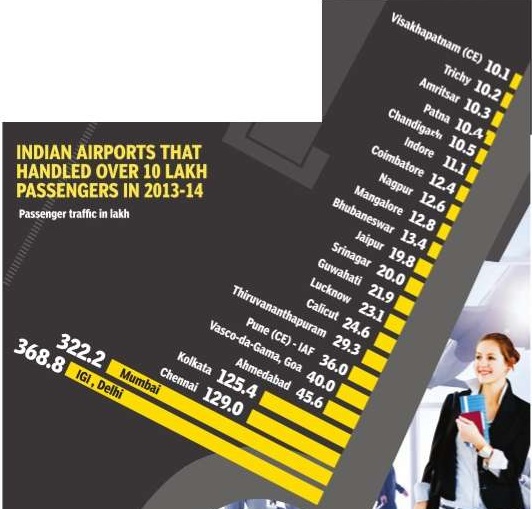
VT code
The Times of India, May 4, 2016
Many may not be aware of the origins of the term “VT“, which is the registration code of Indian aircraft.It is “Viceroy Territory“ and continues [till 2016] to be a legacy of the British Raj.
BJP MP Tarun Vijay demanded in the Rajya Sabha the government change this code.
Taking up the issue during zero hour, Vijay said, “India cannot be a territory of the Viceroy“ adding that the issue was raised in 2006-07 and 2008. But then civil aviation minister of UPA government had said, “It has been decided not to replace existing VT mark as no other code which distinctly identifies with India was available.“ VT code was given by International Civil Aviation Organisation. The BJP MP from Uttarakhand said that countries including Fiji, Nepal and Pakistan have changed their code, but India is still continuing with the VT code.
See also
Civil Aviation, India/ 1
